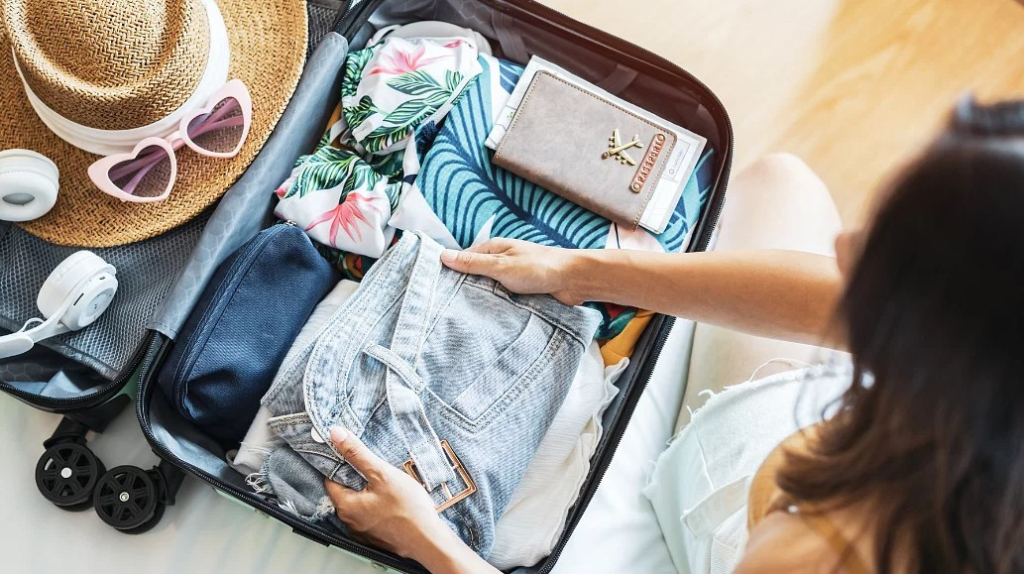Despite having traversed countless miles through the skies, there occasionally arises the pondering of whether certain articles may accompany one within the cabin. Let us unravel the enigma surrounding what is permissible and what is prohibited aboard an aircraft, be it in the realm of hand luggage or checked baggage. Await the elucidation of the most urgent inquiries!
What you can’t take in your hand luggage on an airplane
Larger quantities of fluids exceeding 100 ml are prohibited. In other words, it is impermissible to carry 100 ml of shampoo in a container of 200 ml. The cumulative liquid volume must not surpass 1 liter per individual, with the exception of baby sustenance, dietary provisions, and medicinal items. The latter two necessitate a physician’s endorsement. For further elucidation on liquid regulations, please peruse the comprehensive guidelines.
- Objects capable of inflicting punctures or lacerations require diligent scrutiny as a precautionary measure. Disposable razors, razors equipped with interchangeable cartridges, and electric razors are permissible in hand luggage. Certain airlines may authorize the inclusion of tweezers, clippers, nail files, knives, and scissors with blades shorter than 6 cm—do verify with your respective airline’s website. For instance, we have never been compelled to relinquish tweezers, wire cutters, or nail scissors from our carry-on bags, while acquaintances inadvertently carried a knife in their carry-on luggage.
- Weapons and their facsimiles are unequivocally prohibited from being surreptitiously conveyed into the cabin—this holds true even for a toy sword, which must be relegated to checked luggage. I once witnessed a water pistol being confiscated from a child at customs and summarily discarded. All such items are exclusively permitted within checked baggage. A legitimate permit is indispensable for the possession of an actual firearm.
- Alcoholic beverages may only be carried if they are contained within bottles of no more than 100 ml. Should you be transporting a treasured homemade tincture or a bottle of Georgian wine, it must be stowed away in checked luggage. As for duty-free alcohol, select airlines may authorize its carriage on board, provided it remains sealed within a bag accompanied by a receipt. On one occasion, we transported liquor as a gift from Istanbul within a securely sealed bag.
- Explosive substances and sundry perilous articles are strictly prohibited from both checked luggage and hand luggage. This includes items such as Zippa petrol lighters, self-defense gas canisters, and hiking torches. However, a disposable lighter is permissible for carriage within your hand luggage or pocket.
- Lithium-ion batteries merit special attention, for they possess the potential to combust under elevated temperatures. It is advisable to seek explicit clarification from the airline, yet as a general rule, the following guidelines apply: if the battery capacity is modest (up to 100W⋅h), it may be transported in your hand luggage, securely inserted within a device. Should the capacity fall within the range of 100-160W⋅h, the consent of the airline is requisite. Batteries exceeding 160W⋅h are classified as hazardous materials and necessitate an official permit for transport.
We carry a power bank boasting a capacity of 20,000 mAh, equating to less than 100W⋅h. Additionally, we transport three drone batteries, with their contacts thoughtfully taped together. These items are meticulously packed within a case and accompany us as part of our hand luggage.
More useful tips for travelers can be found here – happywayfarer.com
What to take in hand luggage?
Here, I shall enumerate the articles that not only are permissible for carriage aboard an aircraft as carry-on baggage, but are indeed recommended.

- A mask is an imperative in contemporary times, an absolute necessity!
- Gadgets. All delicate and costly technological devices ought to be stowed in the cabin baggage: laptop, camera, tablet, media player, e-book. Furthermore, they shall alleviate the monotony of your journey! However, it should be noted that certain airlines may prohibit the boarding and acceptance of the Samsung Galaxy Note 7 due to the potential hazard of its battery detonating.
- Documents and monetary funds. This matter requires no deliberation, as they should remain in your possession.
- Adequate warm garments. I invariably carry a lightweight scarf and blouse, and during lengthy flights, a thin sweatshirt. Throughout the journey, I often succumb to slumber, only to find myself shivering beneath the chilling effects of the air conditioning. This predicament is particularly prevalent with Asian airlines, which seem to have an inclination for subjecting their passengers to frigid temperatures.
- Medicinal provisions. In my cabin baggage, I always ensure the inclusion of a compact emergency kit containing remedies for allergies, motion sickness, and citramine. In the event of a cold, nasal drops and medications for alleviating throat discomfort are indispensable.
- Moist towelettes or antiseptic agents. These versatile commodities prove to be invaluable. They can be employed to invigorate the skin, cleanse soiled or dusty surfaces, and disinfect the hands.
- A neck pillow serves its purpose only during extensive flights, for it proves to be an inconvenience on shorter ones.
- Provisions. It is permissible to carry sustenance on board. However, within cabin baggage, all liquid and malleable substances must be confined to containers not exceeding 100 ml in volume. This restriction applies to beverages, preserves, honey, and, rather unexpectedly, Brie and Camembert cheese! Conversely, solid food items may be transported without constraint. Furthermore, no restrictions are imposed on baby food.
Certain countries proscribe the transportation of food derived from animals. Likewise, odorous products such as fish sauce and durian are strictly prohibited.
Rules of carrying liquids in hand luggage
This is arguably the most ubiquitous inquiry among tourists. And I frequently witness shampoos, sprays, lens products, and even plain water being confiscated at customs. Our water was taken away as well, although occasionally it goes unnoticed. On one occasion, we were allowed to pass with a half-filled large lens fluid, but I would not recommend taking such a risk.
In essence, bear in mind how liquids ought to be transported in your carry-on baggage:
• All liquids must be contained in bottles of no more than 100 ml.
• The cumulative volume of all liquids should not exceed 1 liter per individual.
• All bottles must be securely sealed within a transparent zip-lock bag, measuring approximately 20 x 20 cm.
• Liquids encompass beverages, gels, shampoos, toothpaste, creams, lotions, perfumes, foams, aerosols, sprays (such as deodorant), medications (syrups, lotions, ointments), and even mascara and lip gloss.
If you genuinely require water, procure it from duty-free shops or carry an empty bottle from home. You can fill it with potable water within the designated clean zone (although not all airports offer this option). Alternatively, you may kindly request the assistance of a flight attendant to fill your bottle with water.
Where can I obtain travel-sized bottles? They are available for purchase in stores, although I personally repurpose the used ones from hotel shampoos, makeup samples, and miniature soy sauce bottles.
Where can I acquire a transparent zip-lock bag? These are obtainable in stationery departments or cosmetics stores. Moreover, it is unnecessary for the bag to have a zipper closure exclusively; a combination of a zipper and a button suffices, as pickiness is nonexistent.
What medicines can you take on the plane
Let us delve further into the subject of medications. What are the permissible items to bring aboard an aircraft? Indeed, you may carry any necessary medications as long as they adhere to the stipulated conditions. A conventional first aid kit will not give rise to any inquiries. Familiarize yourself with the art of packing a travel-ready first aid kit.
Ideally, the medications should retain their original packaging, complete with accompanying instructions. However, to conserve space, I personally store them in blister packs secured with a rubber band – this practice has never drawn any scrutiny from customs officials.
The regulation pertaining to the transportation of liquids also extends to medications. In other words, only quantities of up to 100 ml are permissible within your carry-on luggage. Exceptions exist for life-sustaining medications, although a medical certificate is required. Further information on this topic can be found in the section dedicated to liquids.
Should you be carrying medications containing psychotropic or narcotic substances while traveling abroad, it is essential to ascertain the specific medications permissible in the destination country. Obtain a doctor’s prescription with the drug name recorded in Latin. Please bear in mind that such medications must be declared upon arrival.
In the event that you require needles for injections, it is likewise advisable to possess a certificate. Failure to do so may necessitate placing them in your checked luggage.
What it is strictly forbidden to take on the plane
This is a standard list of things that are strictly prohibited to take on the plane – you won’t find it in the suitcase of an ordinary traveler. Here’s what you cannot take neither in hand luggage, nor carry in luggage:
- magnetized materials;
- explosives;
- arms and ammunition;
- poisonous or poisonous substances;
- flammable liquids;
- flammable solids;
- radioactive materials;
- compressed and liquefied gases;
- toxic materials;
- caustic and corrosive materials;
- oxidizing substances and organic peroxides.
7 Responsible Travel Rules
To evade any concerns regarding baggage, carry-on provisions, excessive weight, or restricted articles, adhere to these straightforward guidelines:
- Familiarize yourself with the regulations pertaining to items prohibited for import or export, as well as their permissible quantities. For instance, transporting coral outside Egypt and certain other countries, unless acquired from a licensed establishment, is strictly forbidden.
- Ensure that you acquaint yourself with the luggage and carry-on regulations of the airline you are flying with, as they may vary considerably, particularly when it comes to low-cost carriers. The stringent policies of Pobeda Airlines are likely well-known to many.
- If you harbor concerns about surpassing weight limits and wish to avoid incurring additional charges for your luggage, it is prudent to ascertain the weight of your bag in advance, either by utilizing a scale or by locating a measuring station at the airport.
- While certain items, such as umbrellas, walking sticks, crutches, electronic appliances, strollers, or outerwear, may be disallowed in carry-on luggage, numerous airlines permit their inclusion within your hand luggage.
- Reserve the majority of your possessions for check-in baggage, opting to carry only the essential items aboard the aircraft.
- Refrain from stowing valuable or delicate objects, important documents, or equipment within your checked luggage.
- In the event that you possess oversized or irregularly shaped luggage, travel with pets, or encounter any other exceptional circumstances, kindly seek guidance from the airline staff.








